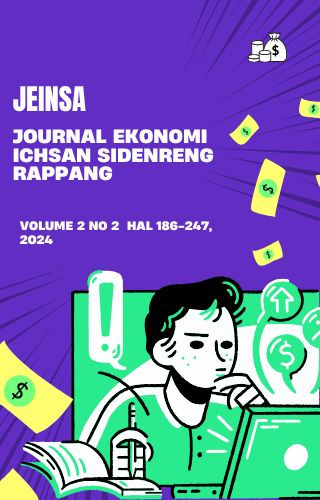ANALYSIS OF DETERMINANTS OF THE HUMAN DEVELOPMENT INDEX ON THE ISLAND OF SULAWESI (2010-2022)
DOI:
https://doi.org/10.61912/jeinsa.v2i2.28Keywords:
Human Development Index, Unemployment, Poverty, Capital ExpendituresAbstract
This research aims to analyze the factors that influence the Human Development Index (HDI) on Sulawesi Island in 2010-2022. This research uses multiple regression analysis with the Human Development Index as the dependent variable, while the open unemployment rate, poverty and capital expenditure as independent variables. The data source in this research is secondary data in the form of data on the open unemployment rate, the number of poor people and the realization of capital expenditure. The results of this research show that the open unemployment rate variable and the capital expenditure variable have a positive and significant effect on the Human Development Index variable on Sulawesi Island in 2010-2022. Meanwhile, the poverty variable shows that the results have a negative and significant effect on the Human Development Index variable on Sulawesi Island in 2010-2022. It is hoped that the government of each province on the island of Sulawesi can create policies that are more effective in increasing the human development index in their regions, namely reducing the level of open unemployment by creating more job opportunities, so that the number of poor people decreases and can get better education and health facilities. Good. Furthermore, the government of each province on Sulawesi Island is expected to be able to utilize all the resources it has in order to have maximum regional income and be able to realize each regional budget appropriately and effectively in order to accelerate the development of their respective regions.
References
Darmawan, M. J. (2020). Analisis Dimensi Ketimpangan Pembangunan Antar Wilayah Di Provinsi Jawa Timur Tahun 2014-2018. UPN" VETERAN" JATIM.
Hartono, B. (2008). Analisis ketimpangan pembangunan ekonomi di provinsi jawa tengah. Semarang: Program Pascasarjana Universitas Diponegoro.
Julianto, D., & Utari, P. A. (2019). Analisa pengaruh tingkat pendidikan terhadap pendapatan individu di Sumatera Barat. Ikraith-Ekonomika, 2(2), 122–131.
Kautsar, A., & Edi, J. (2017). Pendidikan Karakter Religius, Disiplin dan Bakat Melalui Penigkatkan Kualitas Sarana Prasarana Sekolah. JMKSP (Jurnal Manajemen, Kepemimpinan, dan Supervisi Pendidikan), 2(2), 259–277.
Kiha, E. K., Seran, S., & Lau, H. T. (2021). Pengaruh jumlah penduduk, pengangguran, dan kemiskinan terhadap indeks pembangunan manusia (ipm) di kabupaten belu. Jurnal Ekonomi, Sosial & Humaniora, 2(07), 60–84.
Mahmut, C., Fatmawati, F., & Anwar, A. I. (2022). Analisis Kesejahteraan Masyarakat di Provinsi Sulawesi Selatan. SEIKO: Journal of Management & Business, 5(2), 452–461.
Mirza, D. S. (2012). Pengaruh kemiskinan, pertumbuhan ekonomi, dan belanja modal terhadap indeks pembangunan manusia di Jawa Tengah tahun 2006-2009. Economics Development Analysis Journal, 1(2).
Muliza, M., Zulham, T., & Seftarita, C. (2017). Analisis pengaruh belanja pendidikan, belanja kesehatan, tingkat kemiskinan dan PDRB terhadap IPM di provinsi Aceh. Jurnal Perspektif Ekonomi Darussalam (Darussalam Journal of Economic Perspec, 3(1), 51–69.
Purnomo, R. A. (2016). Ekonomi Kreatif Pilar Pembangunan Indonesia. Ziyad Visi Media.
Ristika, E. D., Primandhana, W. P., & Wahed, M. (2021). Analisis Pengaruh Jumlah Penduduk, Tingkat Pengangguran Terbuka Dan Indeks Pembangunan Manusia Terhadap Tingkat Kemiskinan Di Provinsi Jawa Timur. Eksis: Jurnal Ilmiah Ekonomi dan Bisnis, 12(2), 129–136.
Sari, B. N., & Priati, P. (2016). Identifikasi Keterkaitan Variabel dan Prediksi Indeks Pembangunan Manusia (IPM) Provinsi Jawa Barat Menggunakan Dynamic Bayesian Networks. Jurnal Infotel, 8(2), 150–155.
Schultz, T. W. (1961). Investment in human capital. The American economic review, 51(1), 1–17.
Sidabutar, S., Purba, E., & Panjaitan, P. D. (2020). Pengaruh Pengeluaran Pemerintah Bidang Pendidikan Dan Kemiskinan Terhadap IPM Kabupaten Simalungun. Jurnal Ekuilnomi, 2(2), 86–101.
Statistik, B. P. (2020). Indeks pembangunan manusia. Retrieved Februari, 18.
UNDP, A. (2016). Africa human development report 2016 accelerating gender equality and women’s empowerment in Africa. United Nations Development Programme (UNDP).
Vildzah, N., & Muhammad, S. (2016). Faktor-Faktor Yang Mempengaruhi Indeks Pembangunan Manusia di Negara Miskin Asia Dan Afrika. Jurnal Ilmiah Mahasiswa Ekonomi Pembangunan, 1(2), 429–437.
Wajdi, M. F., & Isa, M. (2014). Membangun Konsep Modal Manusia Yang Berperanan Dalam Kinerja Pemasaran Industri Kecil.
Zakaria, R. (2018). Pengaruh Tingkat Jumlah Penduduk, Pengangguran, Kemiskinan, Pertumbuhan Ekonomi, dan Belanja Modal Terhadap Indeks Pembangunan Manusia di Provinsi Jawa Tengah Tahun 2010-2016.
Margaretha, (2014), Studi Mengenai Loyalitas Pelanggan Pada Divisi Marzuki, (2015), Metodologi Riset, Yogyakarta: Ekonisia.
Noerani, I . A. (2016). Pengaruh tingkat kepercayaan, kualitas pelayanan, dan harga terhadap kepuasan pelanggan Jne Surabaya. Jurnal ilmu dan Riset Manajemen 5 (5): 7-16
Downloads
Published
How to Cite
Issue
Section
License
Copyright (c) 2023 Jurnal Ekonomi Ichsan Sidenreng Rappang

This work is licensed under a Creative Commons Attribution-NonCommercial-ShareAlike 4.0 International License.
All writing in this journal is the sole responsibility of the author. Jeinsa provides open access to anyone so that the information and findings in these articles are useful for everyone. Jeinsa can be accessed and downloaded for free, free of charge, following the 
Jeinsa : Jurnal Ekonomi Sidenreng Rappang is licensed under a Creative Commons Attribution 4.0 International License.












